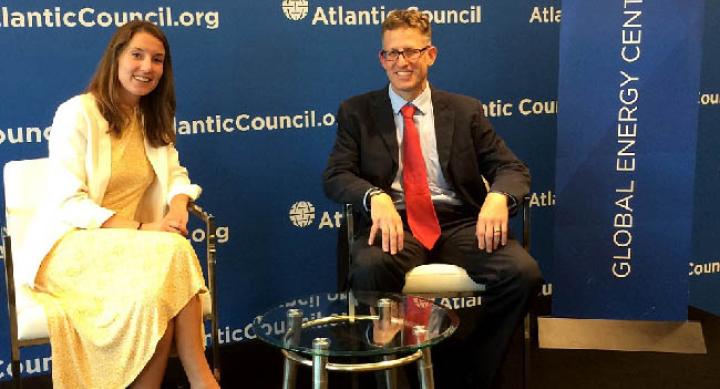
LBJ alumna Ellen Scholl and Professor Josh Busby at the Atlantic Council in Washington, DC.
Joshua Busby, an associate professor of public affairs and leading expert on environmental politics, published two reports on climate change in September 2018.
The first report, published by the Atlantic Council with co-author Nigel Purvis, analyzes climate leadership in uncertain times and concludes that international climate cooperation has both promise and potential, despite the United States scaling back its leadership.
LISTEN: Busby on how today's climate change will affect tomorrow's foreign policy (The Chicago Council on Global Affairs' "Deep Dish on Global Affairs" podcast, Sept. 20, 2018)
"While climate policy in Washington is moving in the wrong direction, the clean energy economy has momentum," Busby said. "Renewables and cleaner natural gas are driving down U.S. emissions, and renewables are growing rapidly around the world. There are opportunities even now to make progress globally to address climate change through targeted efforts in key areas."
"There are opportunities even now to make progress globally to address climate change through targeted efforts in key areas.” —Professor Josh Busby
The authors explore the potential for climate leadership around the world and identify a handful of areas where progress can be made. A number of middle powers, subnational actors and non-state actors have reaffirmed their commitment to climate leadership, most visibly the state of California. High-impact areas for a diplomatic agenda include building a carbon neutrality alliance, scaling up electric vehicles, and developing an air pollution initiative for Asian cities.
At the Global Climate Action Summit, @Climate_Intel and I also launched a paper with @AtlanticCouncil on global climate leadership 4/ https://t.co/AKsZBbYubP pic.twitter.com/yBPSzEA1q7
— Josh Busby (@busbyj2) Oct. 11, 2018
Busby and Purvis say they intend to inform a broader conversation about international diplomacy to foster interdisciplinary approaches to issues related to climate change.
Are states, cities and companies taking the lead on climate action? (Washington Post, Sept. 17, 2018)
Later in the month, Busby published a report for USAID on the intersection of climate exposure and state fragility around the world. Researchers identified key global fragility and climate patterns, as well as country-specific risks, to understand how these factors create instability, strain state capacity and undermine human security.
The study also produced several new analytical products, including a composite measure of climate exposure to identify patterns worldwide; a longitudinal fragility measure that assesses state effectiveness and legitimacy in the political, security, economic and social spheres of states worldwide; metrics on the number and proportion of people facing high and very high exposure in fragile states; metrics on the amount of territory facing very high exposure in fragile states; and maps showing the locations of overall climate exposure and individual hazard risks, overall fragility and sectoral risks, and the intersection of fragility and climate risks worldwide.
The Double Burden of Climate Exposure and State Fragility (New Security Beat, Oct. 15, 2018)
"The report's main aim was to identify places facing the double burden or high climate exposure and high fragility, but the analysis also helped identify possible policy interventions," Busby said. "Where climate risks were geographically concentrated, policies could be targeted to address specific risks. Where exposure was more geographically extensive, policies likely need to broaden."
A majority of highly fragile states, where combined measures of state effectiveness and legitimacy are problematic — 26 of the 39 states identified to have the highest or high fragility — have a large number of people or large proportion of the population facing high climate risks. India stands out, with more than 118 million people in high exposure areas. Responding to climate hazards can require substantial resources, infrastructure and mobilization — sometimes repeatedly. These threats and responses can exceed state capacity and social capital.
Congratulations to Professor @busbyj2 on his research accomplishments, having published 2 reports in September on climate change for @USAID and @AtlanticCouncil. AE https://t.co/mDAS4TVxKq
— The LBJ School (@TheLBJSchool) Oct. 15, 2018
The authors of this study identify several opportunities for action, including reducing climate vulnerabilities and investments to improve state capacity to respond to climate risks.
Busby on how to make climate security research policy relevant in Current Climate Change Reports: Taking Stock: the Field of Climate and Security (September 2018)

